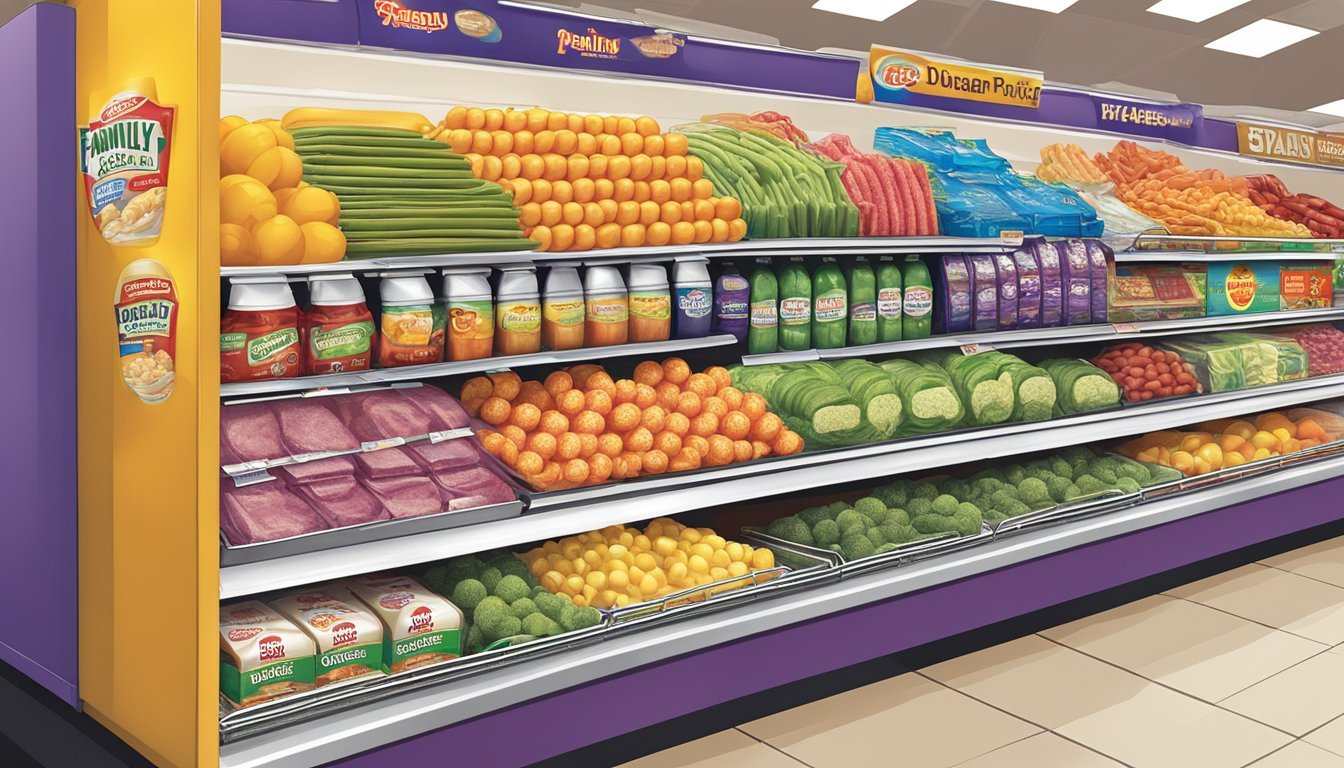Is Family Dollar Cheaper Than Piggly Wiggly?
A Price Comparison Analysis
Family Dollar and Piggly Wiggly are both popular shopping destinations for budget-conscious consumers. While Family Dollar focuses on offering a wide range of household items and groceries at discounted prices, Piggly Wiggly is a traditional grocery store with a local, community-oriented approach. Many shoppers wonder which of these two stores offers better value for their money.
When comparing overall prices, Family Dollar generally offers lower prices on many items compared to Piggly Wiggly. Family Dollar's business model is centered around providing everyday essentials at discounted rates, which often results in cheaper prices for common household goods and non-perishable food items. However, it's important to note that the product selection and availability can vary between the two stores.
The shopping experience at Family Dollar and Piggly Wiggly differs significantly. Family Dollar typically has a more limited selection of fresh produce and meats, while Piggly Wiggly offers a full-service grocery experience with a wider variety of fresh foods. Shoppers looking to save money on their overall grocery bill may find better deals at Family Dollar, but those seeking a broader range of fresh options might prefer Piggly Wiggly despite potentially higher prices on some items.
Understanding Grocery Retailers
Grocery retailers have evolved significantly over time, offering consumers various options for their shopping needs. These stores range from traditional supermarkets to discount chains, each with unique characteristics and target markets.
History of Grocery Stores
The modern grocery store concept emerged in the early 20th century. In 1916, Clarence Saunders founded Piggly Wiggly in Memphis, Tennessee, introducing the revolutionary self-service model. This innovation allowed customers to browse and select items themselves, reducing labor costs and increasing efficiency.
Prior to this, shoppers relied on clerks to retrieve items from behind counters. The self-service model quickly spread, transforming the retail landscape. Chain stores like A&P expanded rapidly, offering lower prices through economies of scale.
In the 1930s, supermarkets began to appear, combining grocery, produce, meat, and dairy departments under one roof. This "one-stop shop" concept further revolutionized the industry.
Types of Grocery Retailers
Grocery retailers today encompass a wide spectrum of formats:
Traditional Supermarkets: Examples include Kroger and Publix, offering a full range of products and services.
Discount Stores: Walmart and Aldi focus on low prices, often with limited product selection.
Warehouse Clubs: Costco and Sam's Club sell bulk items at discounted prices to members.
Specialty Stores: Trader Joe's and Whole Foods cater to niche markets with curated product selections.
Convenience Stores: These smaller formats offer quick shopping for essential items.
Online Retailers: Amazon and other e-commerce platforms have entered the grocery market, offering home delivery and pickup options.
Each type of retailer targets different consumer needs, from budget-conscious shoppers to those seeking premium or specialized products.
Price Factors in Grocery Shopping
Grocery prices are influenced by various elements that impact both retailers and consumers. Understanding these factors can help shoppers make informed decisions and potentially save money on their purchases.
Importance of Pricing
Pricing plays a crucial role in grocery shopping decisions. Many consumers prioritize finding the best deals to stretch their grocery budgets. Lower prices often attract more customers, leading to increased sales volumes for stores.
Retailers use pricing strategies to remain competitive and appeal to budget-conscious shoppers. Some stores offer "Everyday Low Prices" on staple items to build customer loyalty. Others use temporary discounts and sales to draw in shoppers.
Coupons and loyalty programs provide additional ways for consumers to save money. These incentives can significantly reduce costs for savvy shoppers who plan their purchases carefully.
Variables Affecting Prices
Several factors contribute to the final price of grocery items. Supply and demand dynamics play a key role, with prices fluctuating based on product availability and consumer interest.
Seasonal variations impact produce prices, with in-season fruits and vegetables typically costing less. Transportation costs affect pricing, especially for items shipped long distances.
Store location influences overhead costs, which can be reflected in higher prices in urban areas. Competition in the local market can drive prices down as stores vie for customer loyalty.
Bulk buying often results in lower per-unit prices, benefiting both retailers and consumers who can purchase larger quantities. Private label or store brand products usually cost less than national brands, offering budget-friendly alternatives.
Economic conditions, including inflation and changes in production costs, can lead to price adjustments across various product categories.
Product Selection and Availability
Family Dollar and Piggly Wiggly offer distinct product selections tailored to their target customers. Each store has its own strengths in terms of variety and availability across different food categories.
Comparing Food Categories
Family Dollar focuses on providing a limited selection of essential groceries and household items at budget-friendly prices. Their food offerings typically include shelf-stable products, frozen foods, and some basic refrigerated items. Canned goods, snacks, and boxed meals are readily available.
Piggly Wiggly, as a full-service grocery store, offers a more comprehensive selection. Their produce section features fresh fruits and vegetables, often sourced locally. The meat department provides various cuts of beef, pork, and poultry. Dairy cases are well-stocked with milk, cheese, and yogurt options.
Piggly Wiggly's bakery and deli departments offer freshly baked goods and prepared foods, which are not typically found at Family Dollar. For organic and specialty items, Piggly Wiggly generally provides more choices than Family Dollar.
Quality and Freshness
Family Dollar's food products are primarily packaged and shelf-stable items. Their frozen foods and limited refrigerated selections maintain consistent quality due to their packaging and storage methods.
Piggly Wiggly places a stronger emphasis on fresh produce, meats, and dairy. Their regular stock rotation and focus on perishables often result in fresher options for customers. The store's commitment to local sourcing can contribute to improved freshness in seasonal produce.
Piggly Wiggly's in-store bakery and deli provide daily fresh items, a quality aspect not available at Family Dollar. For packaged goods and name brands, both stores maintain similar quality standards, though Piggly Wiggly may offer a wider range of premium options.
Shopping Experience and Customer Service
Family Dollar and Piggly Wiggly offer distinct shopping experiences and customer service approaches. Each store has its own strengths and weaknesses in terms of in-store atmosphere, digital integration, and overall convenience for customers.
In-Store Experience
Family Dollar stores typically feature a no-frills layout with a focus on budget-friendly items. Aisles are often narrow and packed with a variety of products, from household goods to groceries. The checkout process can be quick, with self-service options available in some locations.
Piggly Wiggly, on the other hand, provides a more traditional grocery store feel. Their stores usually have wider aisles and a greater emphasis on fresh produce and local brands. Customer service at Piggly Wiggly tends to be more personalized, with staff often available to assist shoppers.
Both chains offer digital coupons, but implementation varies. Family Dollar's app allows for easy coupon clipping and redemption at checkout. Piggly Wiggly's digital coupon system may differ by location, as some stores are independently owned.
Online Shopping and Digital Integration
Family Dollar has made strides in e-commerce, offering online shopping with in-store pickup options in many locations. Their website and mobile app provide a user-friendly interface for browsing products and managing digital coupons.
Piggly Wiggly's online presence is less uniform due to its franchise model. Some Piggly Wiggly stores offer online ordering and curbside pickup, while others may not have these services available. The level of digital integration can vary significantly between different Piggly Wiggly locations.
Both retailers have loyalty programs, but Family Dollar's rewards system is typically more standardized across stores. Piggly Wiggly's loyalty offerings may differ based on individual store ownership and local market conditions.
Strategies for Saving Money
Effective money-saving strategies can significantly reduce grocery expenses at Family Dollar and Piggly Wiggly. These approaches focus on maximizing discounts, careful planning, and developing smart shopping habits.
Utilizing Coupons and Sales
Coupons and sales offer excellent opportunities to save money at both Family Dollar and Piggly Wiggly. Shoppers should regularly check store circulars and websites for current promotions. Many stores now offer digital coupons that can be loaded onto loyalty cards for easy use at checkout.
Combining manufacturer coupons with store sales can lead to substantial savings. Some stores allow "stacking" coupons, where multiple discounts can be applied to a single item. Timing purchases to coincide with sales cycles can also maximize savings.
Shoppers should be aware of price matching policies. Some stores will match competitors' advertised prices, potentially offering the convenience of one-stop shopping while still securing the best deals.
Budgeting and Meal Planning
Creating a grocery budget and planning meals in advance are crucial steps for reducing food costs. Shoppers should determine a realistic weekly or monthly grocery budget based on their household size and dietary needs.
Meal planning helps avoid impulse purchases and reduces food waste. Before shopping, individuals should inventory their pantry and refrigerator to avoid buying unnecessary items. Planning meals around sale items and seasonal produce can further reduce costs.
Creating a detailed grocery list based on meal plans keeps shoppers focused and less likely to overspend. Many find it helpful to categorize their list by store layout for efficient shopping.
Smart Shopping Habits
Developing smart shopping habits can lead to consistent savings over time. Comparing unit prices helps identify the best value, as larger packages often cost less per unit. However, shoppers should only buy in bulk if the items will be used before expiring.
Generic or store-brand products often offer similar quality at lower prices compared to name brands. Shoppers should be willing to try these alternatives to find cost-effective options that meet their needs.
Shopping during off-peak hours can reduce the temptation of impulse buys. Some stores offer additional discounts on perishable items later in the day. Being flexible with brands and specific products allows shoppers to take advantage of unexpected sales or markdowns.
Comparative Analysis of Family Dollar and Piggly Wiggly
Family Dollar and Piggly Wiggly offer distinct shopping experiences with varying price points across different product categories. Their approaches to pricing and value differ in key areas.
Price Comparison by Category
Family Dollar typically offers lower prices on household items and non-perishable goods. Their selection of cleaning supplies, personal care items, and packaged snacks often beats Piggly Wiggly's prices.
Piggly Wiggly tends to have more competitive pricing on fresh produce, meat, and dairy products. Their local focus allows them to source these items more efficiently in many cases.
Grocery staples like bread, eggs, and milk show mixed results between the two stores. Family Dollar may have cheaper options for some name-brand items, while Piggly Wiggly can offer better deals on store brands.
Assessing Overall Value
Family Dollar provides value through its everyday low prices on a wide range of household essentials. Their smaller store format makes quick shopping trips convenient for many customers.
Piggly Wiggly emphasizes community connection and customer service. They often have loyalty programs and weekly specials that can lead to significant savings for regular shoppers.
Product quality can vary between the two stores. Piggly Wiggly generally offers a broader selection of fresh foods and local products. Family Dollar focuses more on shelf-stable and packaged goods.
Location and accessibility play a role in overall value. Family Dollar has more stores nationwide, while Piggly Wiggly maintains a strong presence in certain regions.
Consumer Insights
Family Dollar and Piggly Wiggly attract different types of shoppers with their unique offerings and pricing strategies. Understanding consumer behavior and preferences provides valuable insights into how these stores compete in the budget grocery market.
Shopping Behavior Trends
Budget-conscious shoppers often seek out the lowest prices, driving traffic to discount stores like Family Dollar. Many consumers compare prices across multiple retailers to find the best deals. Family Dollar's low price range has gained attention from shoppers looking to save money on everyday items.
Piggly Wiggly appeals to customers who value a local shopping experience and community connection. Some shoppers prefer Piggly Wiggly's wider selection of groceries and fresh produce compared to dollar stores. Price-sensitive consumers may split their shopping between multiple stores to maximize savings.
Feedback and Customer Reviews
Customer reviews indicate Family Dollar receives praise for its affordable prices on household essentials and snacks. Shoppers appreciate the convenience of finding basic groceries at low costs. Some customers note limited fresh food options as a drawback.
Piggly Wiggly garners positive feedback for its customer service and community focus. Reviews highlight the friendly staff and local product selections. Customers value Piggly Wiggly's competitive pricing on produce and meats. The store's loyalty program and weekly specials receive favorable mentions from regular shoppers.
Organic and health-conscious consumers tend to prefer Piggly Wiggly's broader range of fresh and specialty items. Family Dollar attracts shoppers solely focused on finding the lowest prices for basic goods.







